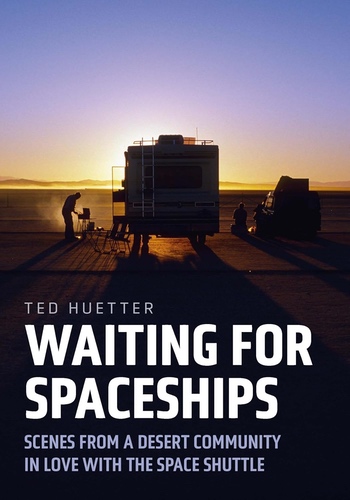Review: Waiting for Spaceshipsby Jeff Foust
|
| The one thing that perhaps made clear this was a space event and not a giant campout was the large number of souvenir vendors, selling shuttle-themed caps, t-shirts, photos, and more. |
His photos, and a brief introduction, describe a community that quickly and briefly came together, drawn by a common interest in the shuttle. There was never any rowdiness that he recalled: “I like to think that the power of the desert environment had a calming effect.” The pictures are a time capsule from the 1980s, from the fashion statements (one person wearing a t-shirt showing a shuttle tearing a hole in the Soviet flag with the caption “We’re Back”) to banners, some produced on dot-matrix printers. One handmade banner declared “We ❤️” followed by illustrations of the American flag and E.T. (Again, it was the ’80s.)
The slender book is primarily photos, with a brief introduction by the author and a foreword by former astronaut Tom Jones, who recalled his visits to Edwards as an Air Force Academy cadet in the mid-70s and, years later, as an astronaut landing there on three shuttle missions. The photos include only brief titles, rather than longer captions, and some of the captions can be a bit cryptic: a man standing on top of an RV looking for the shuttle is titled “Fly Navy”; on closer inspection one sees a “Fly Navy” bumper sticker on the RV.
The emphasis in Waiting for Spaceships is on the “waiting” part, with the shuttle itself making only a cameo appearance in the final pages of the book. The photos capture the public fascination with the shuttle, one that was fleeting: as some of the photos in the book show, attendance dropped over time as the novelty of shuttle wore off. It is a fascinating book for people interested images of that era, although with only a minimum of text to go with it.
Shuttle landings eventually shifted primarily to KSC, with returns to Edwards only in rare situations, like extended poor weather in Florida. The community spirit of those landings, though, lives on in some respects: in 2004, thousands gathered just to the north of Edwards at Mojave Air and Space Port for the SpaceShipOne suborbital flights. More recently, many gathered in South Texas for Starship launches, with local officials reporting hours-long traffic jams exiting a state park at the southern tip of South Padre Island after the most recent launch last week. Both those show the same public interest, and formation of temporary communities, illustrated in Waiting for Spaceships.
Note: we are now moderating comments. There will be a delay in posting comments and no guarantee that all submitted comments will be posted.
